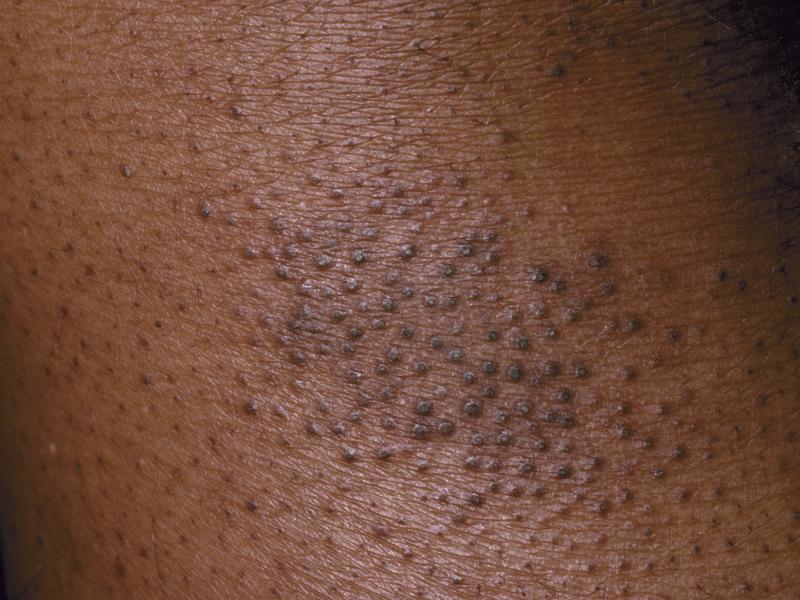VisualDx, a medical informatics company, is celebrating the one-year anniversary of its brainchild Project IMPACT, a global collaborative of nine organizations aiming to reduce health disparities and improve outcomes for patients of color.
The other eight members besides VisualDx include the Skin of Color Society, New England Journal of Medicine Group and the American Academy of Dermatology. Collectively, that includes 1.5 million healthcare professionals globally, including students, the company said. It hopes to add more collaborators this year.
Dark skin is significantly underrepresented in medical teachings and literature, making up less than 5% of images in medical texts. If clinicians are not trained to recognize disease patterns in patients of color, this leads to a delayed diagnosis or a misdiagnosis, which can be life-threatening. Black people, for instance, have lower rates of survival for skin cancer than white people, who are nonetheless much more likely to develop it.

“Project IMPACT was borne out of the concept that healthcare providers who diagnose and treat dermatologic conditions must be able to recognize disease in all skin colors,” Nada Elbuluk, M.D., director of clinical impact at VisualDx, said in an announcement. “We are trying to address healthcare disparities and work toward equity and better outcomes for all, and by rallying people around a singular effort, we can do so.” Anyone interested can take the project's public pledge.
This initiative is meant to share and amplify the work of every organization that is a part of it, Elbuluk told Fierce Healthcare. Everyone brings different resources to the table, a “cross-pollination” with “people more aware of what’s happening outside of their own organizations.”
VisualDx, which has existed for more than two decades, features a curated medical image library of more than 45,000 images of medical conditions on different skin tones and is considered a preferred provider of the American Academy of Dermatology. It is used by more than 100 U.S. medical schools and more than 2,300 providers worldwide, according to the company. One of its solutions, a phone app that recognizes images of skin conditions, has been found to have a high degree of accuracy in diagnosis. Non-dermatologists have also been found to have substantial increases in diagnostic accuracy when using VisualDx. Healthcare professionals can submit images for consideration, which are peer-reviewed for acceptance.

A lot of energy in this movement has come especially from medical students, said VisualDx co-founder and CEO Art Papier, M.D. “Students are actually teaching the teachers about this issue,” he said. He pointed to Queens University in Canada, where medical students reviewed racial bias in their lectures, successfully advocated for the school to license VisualDx technology and even proposed changes to curricula.
If VisualDx is being taught to students, teachers should also be using the tool, “so it’s not 'do as I say,' it’s 'do as I do,'” Papier noted.
The company is also trying to change the traditional training model from memorize-everything to memory-assisted education, recognizing that there is too much medical information to remember accurately today. That means it’s OK to rely on tools like VisualDx in practice.
Through its student advisory board, students advocate for more equitable medical education content. Callyn Iwuala, co-chair of the board and third-year medical student at Cooper Medical School of Rowan University, told Fierce Healthcare that when studying dermatology in medical school, she noticed a lack of skin of color images. Feeling compelled to do something about it, she spoke to her advisor about her concerns. After that, she said, she saw a massive uptick in diverse content. She was heartened to be able to affect change on a local level and to see that “even though we’re medical students, how much power we have,” she said.
Now, it’s her personal goal to expose more students to resources like VisualDx. Her school had already had a subscription, but she only learned of it several years into her studies—through social media. Her school did not promote it, which is why she is trying to.
“There’s no excuse why you shouldn’t be able to take care of a patient who has a different tone than you,” Iwuala said.
Jadesola Temitope Olayinka, also co-chair and a fourth-year medical student at SUNY Downstate, felt inspired to advocate for a resource like VisualDx after being connected to the skin of color-focused dermatology community during her research year, where she saw “such a strong example of the type of public servant I want to be in the future.”
Working with other students, Olayinka successfully convinced her school administration VisualDx was a worthy investment. During that process, one student put a student body survey about the possibility of having the resource and its potential benefits and got a large response.
“There’s just so much more strength in numbers,” Olayinka said.
Iwuala stressed the importance of students using their voices. "You'll be surprised who will stand behind you, and you'll be surprised that your idea can actually create that change," she said.
In that vein, the American Academy of Dermatology announced on Wednesday the launch of a program aimed at doubling the representation of Black, Latino and Indigenous dermatology residents in the next five years. The Pathways: Inclusivity in Dermatology program plans to engage students from high school through medical school, and will offer scholarships, mentorship and training.